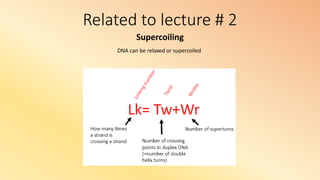
3. direction and elongation of dna replication in prokaryotes
- 1. Related to lecture # 2 Supercoiling DNA can be relaxed or supercoiled
- 4. III. STEPS IN PROKARYOTIC DNA SYNTHESIS Lecture 3 A. Separation of the two complementary DNA strands B. Formation of the replication fork C. Direction of DNA replication D. RNA primer E. Chain elongation F. Excision of RNA primers and their replacement by DNA G. DNA Ligase
- 5. C. Direction of DNA replication • The DNA polymerases responsible for copying the DNA templates are only able to “read” the parental nucleotide sequences in the 3'→5' direction, and they synthesize the new DNA strands only in the 5'→3' (antiparallel) direction. • Therefore, beginning with one parental double helix, the two newly synthesized stretches of nucleotide chains must grow in opposite directions—one in the 5'→3' direction toward the replication fork and one in the 5'→3‘ direction away from the replication fork • This feat is accomplished by a slightly different mechanism on each strand.
- 6. 1. Leading strand • The strand that is being copied in the direction of the advancing replication fork is called the leading strand and is synthesized continuously. 2. Lagging strand • The strand that is being copied in the direction away from the replication fork is synthesized discontinuously, with small fragments of DNA being copied near the replication fork. • These short stretches of discontinuous DNA, termed Okazaki fragments, are eventually joined (ligated) to become a single, continuous strand. • The new strand of DNA produced by this mechanism is termed the lagging strand.
- 7. D. RNA primer • DNA polymerases cannot initiate synthesis of a complementary strand of DNA on a totally single-stranded template. • Rather, they require an RNA primer—that is, a short, double-stranded region consisting of RNA base-paired to the DNA template, with a free hydroxyl group on the 3'-end of the RNA strand • This hydroxyl group serves as the first acceptor of a deoxynucleotide by action of DNA polymerase.
- 9. 1. Primase: • A specific RNA polymerase, called primase (DnaG), synthesizes the short stretches of RNA (approximately ten nucleotides long) that are complementary and antiparallel to the DNA template. • In the resulting hybrid duplex, the U in RNA pairs with A in DNA. • These short RNA sequences are constantly being synthesized at the replication fork on the lagging strand, but only one RNA sequence at the origin of replication is required on the leading strand. • The substrates for this process are 5'-ribonucleoside triphosphates, and pyrophosphate is released as each ribonucleoside monophosphate is added through formation of a 3'→5' phosphodiester bond.
- 10. 2. Primosome: • The addition of primase converts the prepriming complex of proteins required for DNA strand separation to a primosome. • The primosome makes the RNA primer required for leading strand synthesis, and initiates Okazaki fragment formation in lagging strand synthesis. • As with DNA synthesis, the direction of synthesis of the primer is 5'→3'.
- 11. E. Chain elongation • Prokaryotic (and eukaryotic) DNA polymerases elongate a new DNA strand by adding deoxyribonucleotides, one at a time, to the 3'- end of the growing chain • The sequence of nucleotides that are added is dictated by the base sequence of the template strand with which the incoming nucleotides are paired.
- 13. 1. DNA polymerase III: • DNA chain elongation is catalyzed by DNA polymerase III. • Using the 3'-hydroxyl group of the RNA primer as the acceptor of the first deoxyribonucleotide, DNA polymerase III begins to add nucleotides along the single-stranded template that specifies the sequence of bases in the newly synthesized chain. • DNA polymerase III is a highly “processive” enzyme—that is, it remains bound to the template strand as it moves along, and does not diffuse away and then rebind before adding each new nucleotide.
- 15. • The processivity of DNA polymerase III is the result of its β subunit forming a ring that encircles and moves along the template strand of the DNA, thus serving as a sliding DNA clamp. • The new strand grows in the 5'→3' direction, antiparallel to the parental strand. • The nucleotide substrates are 5'-deoxy ribo nucleoside triphosphates. Pyrophosphate (PPi) is released when each new deoxynucleoside monophosphate is added to the growing chain. • Hydrolysis of PPi to 2Pi means that a total of two high-energy bonds are used to drive the addition of each deoxynucleotide. • All four deoxyribonucleoside triphosphates (dATP, dTTP, dCTP, and dGTP) must be present for DNA elongation to occur. • If one of the four is in short supply, DNA synthesis stops when that nucleotide is depleted.
- 16. 2. Proofreading of newly synthesized DNA: • It is highly important for the survival of an organism that the nucleotide sequence of DNA be replicated with as few errors as possible. • Misreading of the template sequence could result in deleterious, perhaps lethal, mutations. • To ensure replication fidelity, DNA polymerase III has, in addition to its 5'→3' polymerase activity, a “proofreading” activity (3'→5' exonuclease, Figure 29.17). • As each nucleotide is added to the chain, DNA polymerase III checks to make certain the added nucleotide is, in fact, correctly matched to its complementary base on the template.
- 17. • If it is not, the 3'→5' exonuclease activity corrects the mistake. • [Note: The enzyme requires an improperly basepaired 3'-hydroxy terminus and, therefore, does not degrade correctly paired nucleotide sequences.] • For example, if the template base is cytosine and the enzyme mistakenly inserts an adenine instead of a guanine into the new chain, the 3'→5' exonuclease activity hydrolytically removes the misplaced nucleotide. • The 5' →3‘ polymerase activity then replaces it with the correct nucleotide containing guanine (see Figure 29.17). • [Note: The proofreading exonuclease activity requires movement in the 3'→5' direction, not 5' →3' like the polymerase activity. This is because the excision must be done in the reverse direction from that of synthesis.]